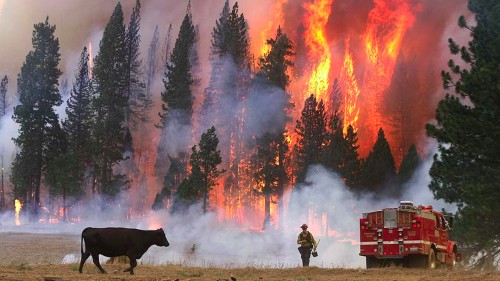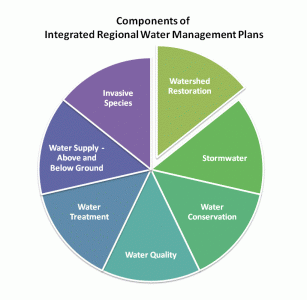Just a few weeks ago, a friend of mine called me in a state of panic saying that San Francisco was recently placed under a state of emergency due to the Rim Fire threatening the city’s water supply. This particular fire burned hundreds of thousands of acres in and around Yosemite National Park and threatened the Hetch Hetchy Reservoir which supplies well over 80% of the San Francisco’s water. It also acted as a major focusing event highlighting the connection between forest, land and water management in the Sierra Nevada. The fire, while started accidentally, was rapidly exacerbated by steep terrain and by the abundance of fuels resultant from poor forest management. The fire also has us water managers in California worried about the threats of increased sediment flow into reservoirs by the end of the first rains of the year. With climate change influencing the strength and frequency of fires in the Sierra Nevada, it is important to think about how such catastrophes can be avoided or at least lessened. To be honest I find it really sad that it took a focusing event of this magnitude to refocus Californian policymakers on the land-water nexus. Regardless, I’ll take this opportunity to argue to you all that properly integrating land and water management in the Sierra Nevada on a regional scale represnts a step in the right direction.

What is Currently Being Done
Land use and water planning are loosely connected through a piecemeal of resources, collaborative planning efforts, and legislation without any overarching policies to bring them all together. Two senate bills SB 221 and SB 610 require developers to prove adequate water supplies in their environmental impact reports as mandated by the California Environmental Quality Act (under normal, wet, dry, and multiple dry years). Municipalities are required to have Urban Water Mangement Plans (UWMPs) that water purveyors and planners use to supply and manage their water resources. Counties have the option of incorporating a “water element” into their general plans which control and regulate growth/development for periods of 25-30 years. Finally, the Department of Water Resources works closely with many regions across the range to develop IRWMPs or Integrated Regional Water Management Plans detailing how water will be managed in a ceratain region. Utilities are also working hard to effectively protect their water resources and conveyance infrastructure by investing in proper land management practices in the upper watershed regions of the Sierra Nevada.
There is currently a push by Sierra Nevada policymakers for utilities, municipalities and government agencies throughout the State to invest in climate-conscious land management strategies as means of avoiding the costs of dealing with something like the Rim Fire while protecting water supply and quality at the same time. This made me VERY happy–finally, land and water being connected… On paper this makes a lot of sense, private sector investment can strongly encourage land use and water planners to coordinate their efforts because money is a universally understood language. However, there are a series of challenges that must be overcome before an avoided cost initiative can be adopted on a regional scale.

What are the Challenges?
Tough Political Ecology: Compared to the rest of California, the Sierra Nevada has some of the strictest development laws around. These laws were designed to protect against sprawl, promote water quality, and ensure the biotic integrity of the Sierra. However, such laws have also stagnated development, disconnected communities and discouraged qualified professionals from moving to the area. Thus the political paradigm is focused on revitalizing the economy.
From a local standpoint, many people have lived here for generations and have a strong aversion to outsiders governing their way of life. The Sierra Nevada economy was built on resource extracting industries (mining, logging, fishing) yet with regulations limiting that way of life, there is a lot of pushback from citizens who fear that their way of life is being compromised. A classic example can be seen by the Agenda 21 (conservative party) group’s ability to snarl County level environmental projects.
Money: Implementing policies that require the coordination of land use and water policy requires scientific, economic and legal research to be conducted before Sierra politicians will consider signing off on such a policy. Many regions in the Sierra are cash-strapped and hesitant to make large investments in land use policies that apply smart water use practices. Furthermore, getting funding for such projects and utilizing the right resources to do so require training which…requires more money. You will often see that Sierra Counties have incredibly strong policies governing development and water use practices yet no way of implementing them.
Timing Disparity: County General Plans are updated every 20-30 years with updates taking place sporadically whereas water mangement plans are often updated every five years or so. Convincing Sierra Counties to coordinate their planning efforts can be difficult due to a lack of resources, communication and scientific understanding. However, citizen advocates, researchers and water managers are rising up to the challenge and are beginning to push for more collaboration between the two plans.
Future Steps
As far as the importance of water management and the threat that climate change poses to water security goes the evidence is almost undeniable. Yet the biggest hurdle that we must face lies within the policy-implementation gap. Focusing events such as the Rim Fire make us clap our hands to our cheeks, turn towards the State Capitol and shout “something must be done!” yet we need to actually do something. Educating the public on basic land use management practices that can improve water supply and quality is a start. Yet environmental awareness is not in itself a panacea, the public must be equally aware of how to influence regional, county and statewide legislative efforts around the land-water nexus.
Final Thoughts
Taking a step back, the importance of the land use-water nexus is not an issue to be neglected until the next big focusing event. It’s an issue that requires us as policymakers to provide the public with the understanding and resources to facilitate change at the local and couty levels.

